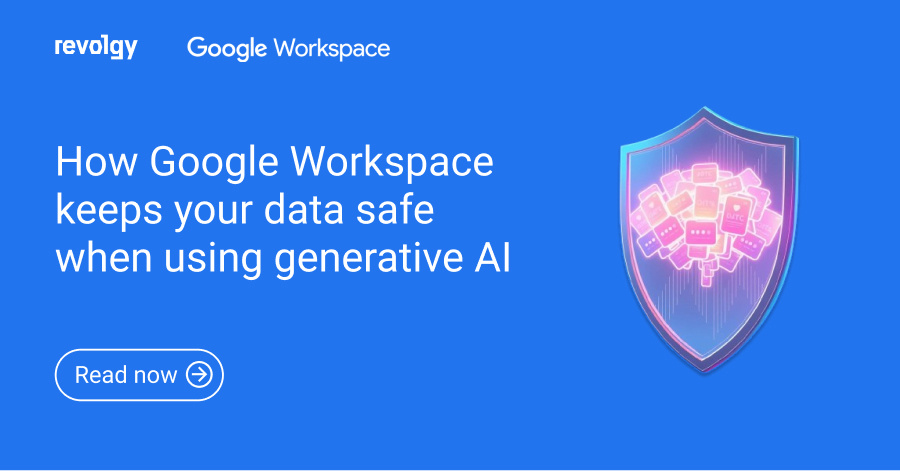Google Workspace
Securing Google Workspace: Best practices and solutions
Securing the organization’s data is more critical than ever for any company. With more businesses transitioning to cloud-based solutions, Google Workspace has become a popular choice for collaboration and productivity. However, as with any platform, ensuring robust Google Workspace security is essential to protect sensitive information and maintain compliance.
In this guide, we’ll explore the best practices for Google Workspace security, dive into specific features and tools, and provide actionable steps to enhance the security of your Google Workspace environment.
Why Google Workspace security matters
Google Workspace security features are designed to protect your data, users, and applications. However, simply relying on default settings is not enough. A proactive approach to
Google Workspace data protection helps prevent unauthorized access, data breaches, and compliance issues. Understanding the various security features and how to implement them effectively is critical to safeguarding your organization.
Key Google Workspace security features
Google Workspace offers a variety of security features to protect your data and ensure safe collaboration:
1. Access control
Managing who can access your data is crucial. Google Workspace provides access control features that allow you to define permissions at both the user and document levels, ensuring that only authorized personnel can view or edit sensitive information.
2. Data encryption
All data in Google Workspace is encrypted in transit and at rest, providing an additional layer of security. This Google Workspace data protection feature ensures that your data remains secure even if intercepted during transmission.
3. Endpoint management
The platform offers endpoint management tools to secure devices that access the Google Workspace environment. These tools allow administrators to enforce policies, such as requiring device encryption or setting up remote wipe capabilities in case a device is lost or stolen.
4. Security audits
Regular Google Workspace security audits help identify potential vulnerabilities and ensure compliance with industry standards. Audits provide insights into how your data is accessed and shared, allowing you to take corrective action if necessary.
Best practices for Google Workspace security
1. Enable Two-Factor Authentication (2FA)
One of the most effective ways to secure Google Workspace is by enabling two-factor authentication (2FA) for all users. This adds an extra layer of security by requiring a second form of verification, such as a mobile device, in addition to a password.
Read more: Why you need Multi-Factor Authentication for Google Workspace
2. Regularly review security settings
It’s essential to periodically review your Google Workspace admin security settings to ensure they align with the latest security best practices. This includes checking who has administrative access, reviewing sharing permissions, and updating security policies.
3. Educate users on security best practices
User awareness is a critical component of Google Workspace security. Educate your team on best practices for Google Workspace security, such as recognizing phishing attempts, creating strong passwords, and securely sharing documents.
4. Implement Data Loss Prevention (DLP) policies
Google Workspace includes Data Loss Prevention (DLP) features that help prevent sensitive information from being shared externally. Configuring DLP policies ensures that data such as credit card numbers or social security numbers are not accidentally or maliciously exposed.
Addressing common Google Workspace security concerns
Many organizations are concerned about Google Workspace’s security vulnerabilities. The good news is that these risks can be effectively managed with the right strategies by admins.
Securing Google Drive data in Google Workspace
Google Drive is a central hub for document storage and collaboration within Google Workspace. To secure Google Drive data, ensure that proper sharing permissions are set, use shared drives for team projects, and regularly audit access logs.
Preventing data breaches in Google Workspace
Data breaches can have severe consequences. Preventing breaches in Google Workspace involves a combination of security best practices, such as enabling 2FA, using strong passwords, and regularly updating security policies.
Managing Security in Google Workspace for enterprises
For larger organizations, managing security can be complex. To enhance security across all levels of the organization, utilize Google Workspace security tools and solutions such as advanced endpoint management, DLP, and third-party integrations.
Google Workspace security compliance
For organizations in regulated industries, ensuring Google Workspace security compliance is non-negotiable. Google Workspace provides features that help meet compliance requirements, such as audit logs, data retention policies, and access control measures.
Google Workspace vs Microsoft 365 security
When comparing Google Workspace vs Microsoft 365 security, both platforms offer robust security features. However, Google Workspace’s seamless integration with other Google services, advanced AI-driven threat detection, and user-friendly interface make it a strong choice for many organizations.
Why choose Revolgy for Google Workspace security
At Revolgy, we specialize in helping businesses optimize and secure their Google Workspace environments. Our tailored solutions address specific security needs, ensuring your organization is protected against evolving threats. Whether you’re a startup or a large enterprise, our expertise in Google Workspace security can help you achieve peace of mind.
Revolgy can help you strengthen your Google Workspace security with tailored workshops and training programs designed for your team.
Revolgy Google Workspace security solutions
We offer a range of services, including Google Workspace security audits, endpoint management, and compliance support. Our team of engineers and architects works closely with you to develop a security strategy that aligns with your business goals and industry requirements.
Conclusion
Securing your Google Workspace environment is not just about ticking off a checklist—it's about creating a culture of security within your organization. By understanding and implementing the best practices for Google Workspace security, you can protect your data, meet compliance standards, and ensure smooth, secure collaboration.
Ready to enhance your Google Workspace security? Contact Revolgy today to learn more about our comprehensive security solutions tailored to your business needs.
Read next: The hidden risks of uncontrolled third-party apps in your Google Workspace
FAQs
Q1: Why is taking a proactive approach to Google Workspace data protection important for organizations?
A proactive approach to Google Workspace data protection helps prevent unauthorized access, data breaches, and compliance issues.
Q2: What are the benefits of using Google Workspace’s data encryption feature?
Data encryption in transit and at rest provides an additional layer of security, ensuring data remains secure even if intercepted during transmission.
Q3: How does enabling Two-Factor Authentication (2FA) enhance Google Workspace security?
Enabling 2FA adds an extra layer of security by requiring a second form of verification in addition to a password.
Q4: What is the purpose of regularly reviewing Google Workspace admin security settings?
Regularly reviewing these settings ensures they align with the latest security best practices, including access, permissions, and policies.
Q5: Why is educating users considered a critical component of Google Workspace security?
User awareness of best practices, like recognizing phishing and creating strong passwords, significantly contributes to overall security.
Q6: How do Data Loss Prevention (DLP) policies in Google Workspace help organizations?
DLP policies help prevent sensitive information, such as credit card or social security numbers, from being shared externally, whether accidentally or maliciously.
Q7: What are the key recommendations for securing Google Drive data within Google Workspace?
Key recommendations include ensuring proper sharing permissions, using shared drives for team projects, and conducting regular audits of access logs.
Q8: For larger organizations, what types of Google Workspace security tools and solutions are beneficial?
Advanced endpoint management, DLP, and third-party integrations are beneficial for enhancing security across all levels of larger organizations.
Q9: What are some of the Google Workspace features that assist organizations in meeting security compliance requirements?
Features like audit logs, data retention policies, and access control measures help organizations meet compliance requirements.
Q10: What are some reasons why an organization might choose Revolgy for their Google Workspace security needs?
Revolgy specializes in optimizing and securing Google Workspace environments with tailored solutions and offers services like security audits, endpoint management, and compliance support.

